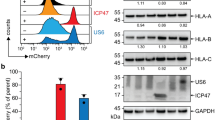Abstract
MAJOR histocompatibility complex (MHC) class I molecules bind and deliver peptides derived from endogenously synthesized proteins to the cell surface for survey by cytotoxic T lymphocytes. It is believed that endogenous antigens are generally degraded in the cytosol, the resulting peptides being translocated into the endoplasmic reticulum where they bind to MHC class I molecules. Transporters containing an ATP-binding cassette encoded by the MHC class II region seem to be responsible for this transport1–8. Genes coding for two subunits of the '20S' proteasome (a multicatalytic proteinase) have been found in the vicinity of the two transporter genes in the MHC class II region, indicating that the proteasome could be the unknown proteolytic entity in the cytosol involved in the generation of MHC class I-binding peptides9–13. By introducing rat genes encoding the MHC-linked transporters into a human cell line lacking both transporter and proteasome subunit genes, we show here that the MHC-encoded proteasome subunits are not essential for stable MHC class I surface expression, or for processing and presentation of antigenic peptides from influenza virus and an intracellular protein.
Similar content being viewed by others
References
Deverson, E. V. et al. Nature 348, 738–741 (1990).
Trowsdale, J. et al. Nature 348, 741–744 (1990).
Spies, T. et al. Nature 348, 744–747 (1990).
Monaco, J. J., Cho, S. & Attaya, M. Science 250, 1723–1726 (1990).
Powis, S. J. et al. Nature 354, 528–531 (1991).
Kelly, A. et al. Nature 355, 641–644 (1992).
Spies, T. et al. Nature 355, 644–646 (1992).
Attaya, M. et al. Nature 355, 647–649 (1992).
Glynne, R. et al. Nature 353, 357–360 (1991).
Brown, M. G., Driscoll, J. & Monaco, J. J. Nature 353, 355–357 (1991).
Ortiz-Navarrete, V. et al. Nature 353, 662–664 (1991).
Martinez, C. K. & Monaco, J. J. Nature 353, 664–667 (1991).
Kelly, A. et al. Nature 353, 667–668 (1991).
Rivett, A. J. Archs Biochem. Biophys. 268, 1–8 (1989).
Salter, R. D., Howell, D. N. & Cresswell, P. Immunogenetics 21, 235–235 (1985).
Townsend, A. et al. Cell 62, 285–295 (1990).
Kvist, S. & Hamann, U. Nature 348, 446–448 (1990).
Ortiz-Navarrete, V. & Hämmerling, G. J. Proc. natn. Acad. Sci. U.S.A. 88, 3594–3597 (1991).
Cerundolo, V. et al. Nature 345, 449–452 (1990).
Hosken, N. A. & Bevan, M. J. Science 248, 367–370 (1990).
Powis, S. J. et al. Nature 357, 211–215 (1992).
Baas, E. J. et al. J. exp. Med. 176, 147–156 (1992).
Henderson, R. A. et al. Science 255, 1264–1266 (1992).
Wei, M. L. & Cresswell, P. Nature 356, 443–446 (1992).
Goulmy, E. Transplant. Rev. 2, 29–53 (1988).
Horai, S., v.d. Poel, J. & Goulmy, E. Immunogenetics 16, 135–142 (1992).
Gotch, F., Rothbard, J., Howland, K., Townsend, A. & McMichael, A. Nature 326, 881–882 (1987).
Müller, C., Shi, L., Schneider, M., Ziegler, A. & Wernet, P. Hum. Immun. 6, 189–197 (1983).
Müller, C. et al. Hum. Immun. 14, 333–349 (1985).
Charron, D. J. & McDevitt, H. O. Proc. natn. Acad. Sci. U.S.A. 76, 6567–6571 (1979).
Müller, C., Ziegler, A., Müller, G., Schunter, F. & Wernet, P. Hum. Immun. 5, 269–281 (1981).
Brodsky, F. M., Parham, P., Barnstable, C. J., Crumpton, M. J. & Bodmer, W. F. Immunol. Rev. 47, 3–61 (1979).
Author information
Authors and Affiliations
Rights and permissions
About this article
Cite this article
Momburg, F., Ortiz-Navarrete, V., Neefjes, J. et al. Proteasome subunits encoded by the major histocompatibility complex are not essential for antigen presentation. Nature 360, 174–177 (1992). https://doi.org/10.1038/360174a0
Received:
Accepted:
Issue Date:
DOI: https://doi.org/10.1038/360174a0
- Springer Nature Limited
This article is cited by
-
Generation of major histocompatibility complex class I antigens: functional interplay between proteasomes and TPPII
Nature Immunology (2004)
-
Hypothesis: MHC class I, rather than just a flagpole for CD8+ T cells is also a protease in its own right
Immunology & Cell Biology (1997)
-
Molecular mechanisms of class I major histocompatibility complex antigen processing and presentation
Immunologic Research (1996)
-
Divergent intron arrangement in theMB1/LMP7 proteasome gene pair
Immunogenetics (1996)
-
Identification of new TAP2 alleles in gorilla: evolution of the locus within hominoids
Immunogenetics (1996)




